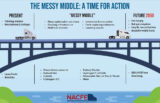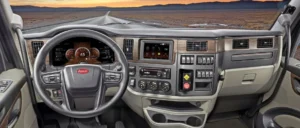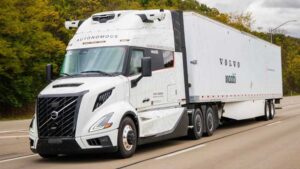ORLANDO, Fla. — The North American Council for Freight Efficiency (NACFE) has released a new thought leadership report on what it dubs the “messy middle” of decarbonizing heavy-duty trucking.
During the messy middle, fleets will be faced with a number of powertrain options, including advanced diesel, renewable fuels, natural gas, hydrogen, hybrids, battery electric power and hydrogen fuel cells with no one right solution for all of the duty cycles, according to a NACFE news release.
“While the messy middle can be complicated, NACFE does not view messy as bad, but rather sees it as a time where fleets will want to take action, will have to evaluate many options and will need to look beyond just the truck to the infrastructure needed to support that truck,” the news release stated.
Robert Ulsh, vice president of dealer and international sales at Great Dane, said that the messy middle is here to stay.
It “will last forever in our industry,” he said. “There is always innovation and continuous improvement. The messy middle is where innovation occurs.”

The primary conclusion of the report is that now is the time for fleets to act and begin to wade into the messy middle in order to get to a zero-emissions future.
“Waiting is no longer an option,” the report notes.
The report also found that all stakeholders should support fleets in making the right adoption decisions, decisions should include a realistic understanding of pipeline capabilities, and an even higher level of collaboration is essential.
“During the messy middle, fleets will need to be open to changing operations to optimize for the new technologies,” said Rick Mihelic, NACFE’s director of emerging technologies. “They will have to look at things like adding stops for charging of battery electric vehicles in regional and long-haul operations and improving intermodal rail use.”
The report identifies key factors for fleets to consider when making the decision about which power options are right for them now and in the future. It also includes a framework for powertrain decisions fleets can use to evaluate their options.
“As a result of the work we did exploring the messy middle, we realized that fleets need to have a better understanding of the options available now and we have begun work on heavy-duty natural gas tractors,” said Mike Roeth, NACFE’s executive director.
The Trucker News Staff produces engaging content for not only TheTrucker.com, but also The Trucker Newspaper, which has been serving the trucking industry for more than 30 years. With a focus on drivers, the Trucker News Staff aims to provide relevant, objective content pertaining to the trucking segment of the transportation industry. The Trucker News Staff is based in Little Rock, Arkansas.















